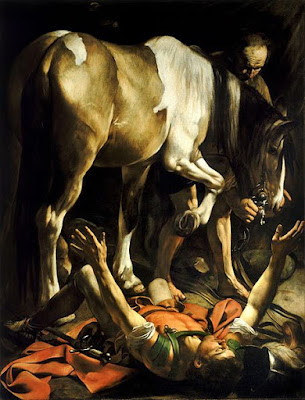Caravaggio . . . and Confucius
 |
| Conversion on the Way to Damascus, 1601 |
As promised in “my resolution,” I have been learning about
the compelling oil paintings of the baroque master Caravaggio. The first thing
a viewer will notice is the extreme employment of chiaroscuro, the
aesthetic of contrasting light and dark elements in a work. Caravaggio’s
backgrounds are so dark it appears that the figures are on stage. Renaissance
paintings tended to feature detailed backgrounds, often to show off the
painter’s facility with perspective, and just as often to show hosts of angels
gathering around the sacred event being depicted. The scenes were idealized.
In his book on Caravaggio, the art historian Troy Thomas
says that the artist “viewed existence from a resolutely human perspective,
candidly depicting the difficulty his mortals had in recognizing divinity,” and
“he articulated his black backgrounds to stand symbolically for humanity’s
incomprehension of things beyond immediate earthly experience.” This not to say
that Caravaggio was atheistic or irreligious. He most certainly was religious,
but he sought to portray the realm of the divine or the supernatural only
through the means of depicting human drama and experience.
As I pondered Thomas’ argument, I recalled the insight of
Confucius, who said that we cannot even understand life, so how are we to
understand death? That makes sense. We have many accounts of the heavens, but
these amount to secondhand information. In Caravaggio’s work, the figures of
the great Biblical dramas struggle to comprehend what is happening, and are no
closer to heaven than you and I.
Regarding the perspective, etc., I am reading a fascinating book on the possible methods used to achieve the precision in Baroque painting. Fascinating. https://www.nytimes.com/2015/06/28/books/review/eye-of-the-beholder-johannes-vermeer-antoni-van-leeuwenhoek-and-the-reinvention-of-seeing.html.
ReplyDeleteI love the Confucius quote, by the way.